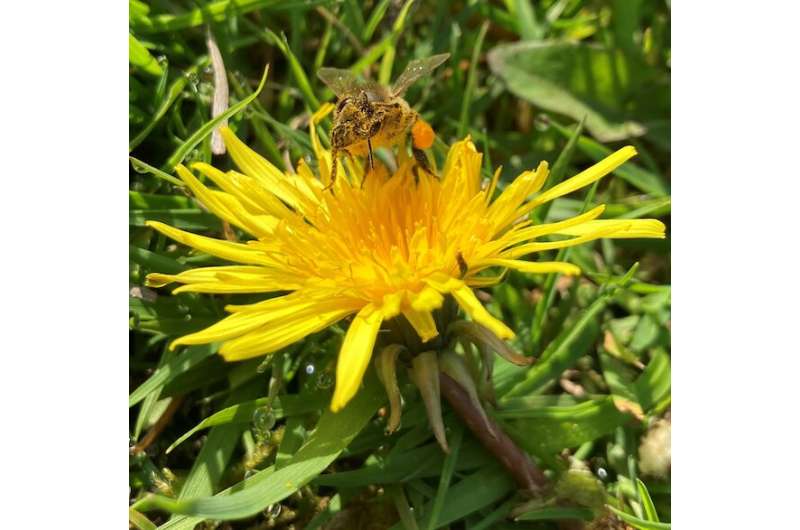This article has been reviewed according to Science X's editorial process and policies. Editors have highlighted the following attributes while ensuring the content's credibility:
fact-checked
trusted source
written by researcher(s)
proofread
Dandelions are a lifeline for bees on the brink. We should learn to love them, says researcher

Dandelions, love them or hate them, are blooming in abundance all over the UK this spring. As an ecologist who studies the insects which visit these flowers, so redolent of sunshine, I have never been able to understand why anyone might hate them.
Why do some people despair when they see a dandelion poking through the grass in their garden, or through the concrete on their drive? Most see dandelions as "weeds": they don't want them around their house and will reach for the lawnmower, or worse still, a can of weed killer, when one dares to rear its yellow head.
Perhaps I'm strange for rejoicing at the sight of a street, lawn or field blooming with dandelion heads. But as these flowers make fantastic food for a wide range of endangered bees, I'd like to convince you to love these flowers as I do, and to care for them as you would any other wildflower in a meadow.
Flowers in the city
The last 50 years have seen urban areas and farms expand across the UK. What few places were set aside to provide for wildlife have been eroded. We have pushed nature to the brink, but nature adapts, changes and overcomes these obstacles.
Studies of bee feeding patterns in cities, where much of their original food sources have been covered with concrete and tarmac, show a shift in their wild, diverse diet to one dominated by dandelions, clover and brambles.
Dandelions are an abundant source of nectar and pollen for bees flying around an environment in which the diversity of food options continues to shrink. These plants grow in very little soil, flower from early spring to just before winter and offer sustenance for bees all year round.
What makes dandelions so successful in feeding a wide variety of pollinators is the shape of their flowers.
The evolution of bees is a dance between the changing shapes of flowers and the corresponding length of bee tongues. Complicated flowers, like vanilla, evolved to make sure only a certain bee species could pollinate them, whereas others have evolved simple, open flowers that anyone can get pollen and nectar from.

Dandelions fall into this second camp. Take a look at a patch of dandelion flowers and you'll be amazed at the diversity of visitors. Over just 10 minutes in my garden I spotted at least 10 different bee and fly species: the ever abundant buff-tailed bumblebee, as well as the common carder bee and a honeybee from one of my own hives working hard to collect pollen for the colony.
Among the many threats to pollinators (pesticides, the destruction of nest habitat, invasive species), lack of food is one of the most important. Highly abundant dandelions can go a long way to bridging this gap—at least in terms of nectar.
Some scientists have argued that dandelion pollen is not the best for bees. Research suggests that it may contain high levels of the essential amino acid proline (which bees can only get from food and cannot make themselves), but lack several others, like isoleucine and valine. A diet lacking in these elements can hamper a bee's ability to grow, resist disease and raise its young.
But in a world where bees are stressed by a lack of any food at all, I would argue that any source that can proliferate under the toughest conditions like dandelions is a worthwhile thing to preserve.
Dandelion dawn
No Mow May approaches: a campaign sponsored by the charity Plantlife to let weeds grow in gardens. Sadly, at the end of May, all that lovely wildflower habitat could be cut down and sprayed with herbicides.
Manicured lawns are essentially green deserts: ostensibly full of plants but with nothing to nourish bees or other wildlife.
Not everyone wants a lawn full of wildflowers. So I would recommend, rather than setting aside the whole garden for nature a month, trying to set aside a patch forever.
Dandelions are amazing plants that can survive anywhere, as long as we allow them. They are a lifeline for pollinators on the brink and need protecting as part of our environment in car parks, roads and lawns. The next time you see a dandelion, try to see it as a bee would.
Provided by The Conversation
This article is republished from The Conversation under a Creative Commons license. Read the original article.![]()



















